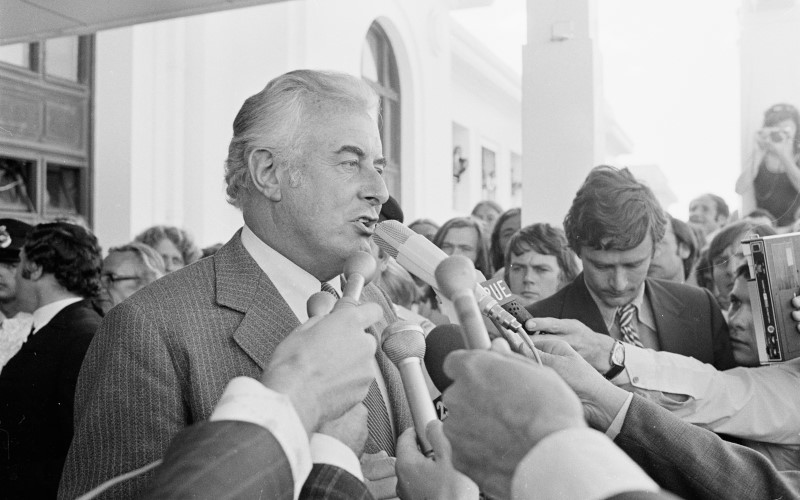Royal fingerprints on the dismissal of Gough Whitlam and our history
November 10, 2021
It’s time for the National Archives to release all letters between the Queen and our governors-general as we move towards becoming a republic.
Today marks the 46th anniversary of the Dismissal of the Whitlam government. We now know that the Queen played a significant role in that unprecedented action, “one of the most controversial and tumultuous events in the modern history of the nation”. It took a four-year legal battle against the National Archives of Australia and a landmark High Court decision in thePalace letters caseto bring that history to light.
The fight to secure our history as public history will never be complete so long as the archives continues to keep its royal records closed from public view. The archives must immediately release the letters between the Queen and all our governors-general, as required under the Archives Act and as it stated it would more than 18 months ago.
The history of the Dismissal is today almost unrecognisable from the incomplete and partial version we were told at the time. The disarmingly simple narrative from that day on was that then governor-general John Kerr had reached a lonely and isolated decision, that he had no other option despite prime minister Gough Whitlam being at Yarralumla to call the half-Senate election that Kerr took his own sole counsel. This was insistently presented by each of the major protagonists: Kerr, his appointed prime minister Liberal party leader Malcolm Fraser, and the chief justice Sir Garfield Barwick. And none of it was true.
Central to this quickly received history was that, most emphatically, the Palace was not involved, that Kerr “protected the Queen”. As the Queens then deputy private secretary, Sir William Heseltine later described it, “the Palace was in a state of total ignorance”. Even as the evident flaws in this view became apparent, the central claim that the Palace was in no way involved in Kerrs decision was the one unchanging and unquestioned element of the Dismissal. And for many years this remained an apparently unassailable position. And yet that too was untrue. The royal fingerprints are all over the Dismissal.
The full history emerged in fragments. First, that Kerr was in secret contact with Fraser before he dismissed Whitlam, then the startling evidence of the protracted role of High Court justice Sir Anthony Mason who, we learned only 37 years later, had played “a most critical part in my thinking at that critical time” as Kerr wrote. Finally, only in the last decade has the extent of royal involvementbecome clear.
Kerr discussed the possibility of dismissing Whitlam with the Queen, her private secretary Sir Martin Charteris, and Prince Charles weeks before he did so. It is also now known that Charteris advised Kerr on the use of the reserve powers to dismiss the government and, as Malcolm Turnbull writes, “some of his correspondence can be read as encouraging him to do so”.
Kerrs own memoirs are often cited as “evidence” that the Queen was aloof from and indifferent to Kerrs decision. Yet one of the most concerning aspects of the Dismissal is that Kerrs memoirs were vetted, stripped of any concerning content about precisely this involvement, by the Palace. Kerrs autobiography can hardly be relied upon for authenticity and verification when it has been royally whitewashed. This is yet another example of the way in which the Palace has distorted the history of the Dismissal, by concealing its own involvement at the time and in the history since.
Despite the mounting evidence of Palace involvement over this last decade,somestill clung defiantly to the myth of royal propriety and neutrality, strenuously denying that Kerr could possibly have forewarned the Palace that he was contemplating Whitlams dismissal. With the release of the Palace letters which describe over several letters this episode of Kerr telling Prince Charles that he might have to dismiss the government, that view is now unsustainable.
Letters from Charteris and Kerr have confirmed that this critical conversation between Charles and Kerr_did_take place in September 1975, at which Kerr told Charteris that he might have to dismiss Whitlam and raised his concern that Whitlam might recall him from office while he was considering doing so. The conversation was then relayed from Charles to the Queen and Charteris and a response to that “contingency”, as Kerr described, it put in place.
This conversation is key to understanding the Palaces involvement as it developed, by agreeing to delay acting on the perfectly proper advice of the prime minister to recall the governor-general should Whitlam have given it, in the context of the possible dismissal of the government, the Palace was already involved. The Queen had entered the domestic political fray in these secret discussions with Kerr, despite later denials, and worse, she had taken his side against the prime minister. She expressed her great displeasure at any such action by Whitlam, “The Queen would take most unkindly to it”, while not remarking at all on the propriety of the governor-general considering dismissing the elected government without warning.
Instead, the Queen indicated that she would delay acting on the prime ministers advice to recall Kerr should that be given. This was critical in Kerrs planning his need to protect his position was his greatest concern and the Queen had provided a safety net. Act quickly and it can still be done. To quote Turnbullagain, “this advice, no doubt, reinforced Kerr in concluding that, to forestall any risk of Whitlam sacking him, he would need to give him no, or very little, warning of his intention”.
A remarkable feature of the Palace letters is that not only do they show the Queen, through Charteris, and the governor-general discussing the fate of the elected government, the tenure of the governor-general, and entering political discussions invariably antithetical to that government, they do so as if the Imperial Conferences of 1926 and 1930 never happened. Those all important Constitutional resets, after which the “constitutional principle” that the Crown acts on the advice of responsible ministers prevailed, specifically established that in the tenure of a governor-general the monarch acts on the prime ministers advice alone. These conversations between the future king Charles, Charteris, the Queen, and Kerr about securing his own tenure and devising a means to delay acting on the advice of the prime minister, were improper in the extreme.
A recently releasedinterview with Sir William Heseltine makes the political nature of this discussion clear and, if there were still any doubt as to its intent, Heseltine describes the impact of such a delay on the Dismissal. It would have given Kerr the time needed to dismiss Whitlam and appoint Fraser. Charteris described this process soon after the Dismissal, at a seminar at which Heseltine was also present. Charteris was asked what the Queen would have done had Whitlam, having heard of Kerrs secret discussions and his plan to dismiss the government, contacted the Palace to request Kerrs recall.
Heseltine recounts the non-lawyer Charteriss response, one which goes against the core requirement that a constitutional monarch to act on the advice of elected government. Charteris claimed, from no particular authority, that Whitlams advice would not have been acted on, that it would have to be in writing and that the Queen “would have been entitled to take her time before responding to it”. Most significantly, as Heseltine recounts, this constructed delay would have given Kerr the time needed to dismiss Whitlam; “in which interval of course the governor-general might have had the opportunity to go ahead and do exactly what he did without giving the prime minister notice”.
The full extent of the Palaces involvement in the Dismissal is now well documented, reflecting a history that has been hard-fought for and decades in the making. We should respect what that history tells us and take a final, long overdue, step away from a Constitutional monarchy and towards Australia as a fully independent republic. Its time.

